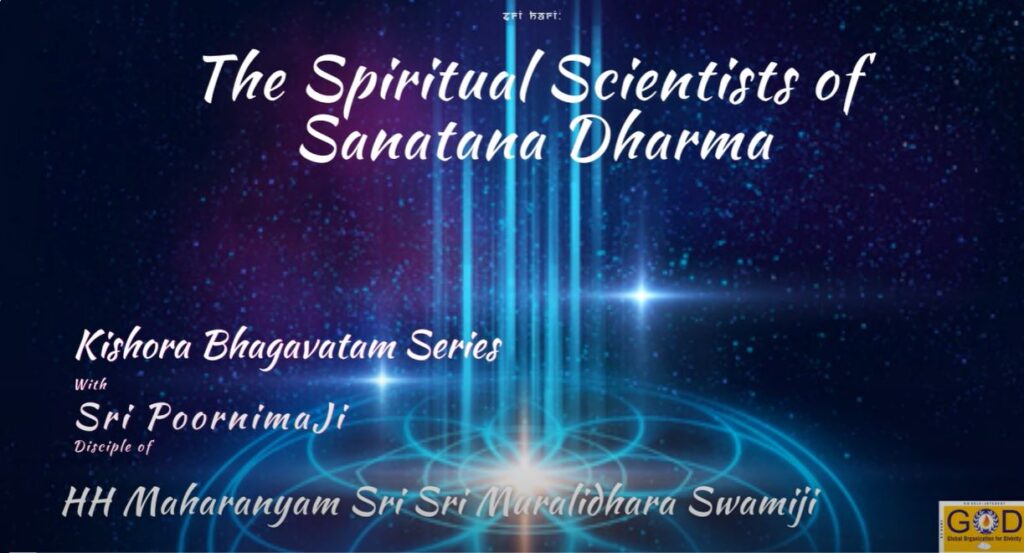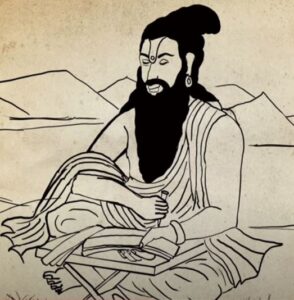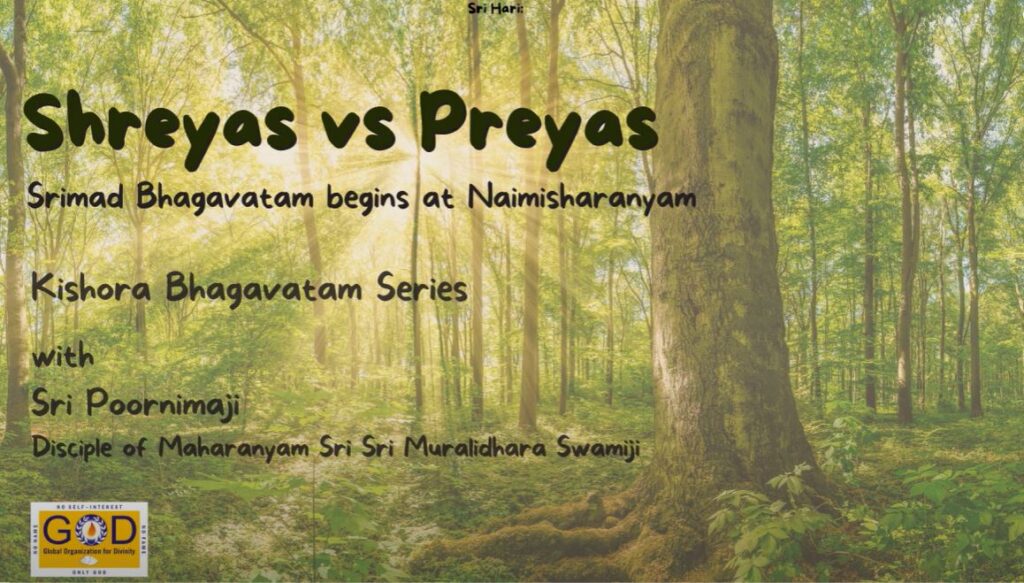
In this episode of Bhagavatam for children, Sri Poornimaji beautifully expounds on the origin and greatness of Srimad Bhagavatam.
Sri Poornimaji starts off by saying Srimad Bhagavatam is Bhagavan Himself. She says that when someone asks us what is so unique about Srimad Bhagavatam, the first thing that we should say is that it is not a mere text, but Bhagavatam is Bhagavan Himself. That is the beauty of Bhagavatam. Srimad Bhagavatam was narrated by Suta Pauranika to Sage Shaunaka and other Maharishis who were gathered at Naimisharanya to perform the Sathra Yaga. The Maharishis posed six very specific questions to Suta Pauranika and the response to those questions led to the birth of Srimad Bhagavatam. Suta Pauranika further explained that Krishna bhakti is the greatest goal one should desire to attain. And Krishna bhakti will flower only when we are under the fold of a satsang. One can attain satsang by visiting various holy kshetras. Initially even if we visit these holy kshetras without much interest, the presence of the presiding deities there and the sadhus will eventually lead us to a satsang. And satsang will strengthen us spiritually and prepares us for bhakti. A devotion that has no conditions is pure love. If there is a condition, then it is more like a business. Unconditional love for Bhagavan is the supreme, and Bhagavatam shows all those great devotees who had such love for Bhagavan. All of them had this kind of bhakti, and even though they had different paths to get there, they all finally attained that state.
Srimad Bhagavatam was blessed by Sage Veda Vyasa, and he is no different from Lord Sri Vishnu. Bhagavan has taken many incarnations. One such incarnation was Sri Veda Vyasa who is the jnana kala avatara of Bhagavan Vishnu. Among all the avatars, Sri Rama and Sri Krishna are purnavataras, and all the others are kalavataras. A kalavatara is when Bhagavan descends only for a particular purpose. Sri Narasimha Avatar is an example of kalavatara. His descent was to purely bless and protect the child Prahlada and kill Hiranyakashipu. Similarly, Sri Veda Vyasa incarnated for a specific purpose and avatarapurushas unless and until they completely fulfill that purpose they’ll never rest. Sri Veda Vyasa incarnated at the end of Dwapara yuga and at the beginning of Kali yuga. Though Sri Vyasa’s incarnation was for the people of Kali yuga, he did not come down in Kali yuga. He is revered as the Guru for us all who practice Sanatana Dharma. He blessed us with all the scriptures, and formulated a guide so that we can learn and benefit from these scriptures. He codified the Vedas, gave the Brahma Sutras, blessed us with Mahabharata and all the Puranas. Rishis like Sri Veda Vyasa are spiritual scientists. A scientist is generally one who questions everything. They are very inquisitive about things. Rishis do this questioning in the spiritual world and like we have absolute confidence in all the scientific findings we should also have faith in our spiritual scientists.

In our Sanatana Dharma we take the word of rishis as a fact, we don’t question it, it is not mere faith it is just the same as how we feel about the scientists of the world. There are two approaches to this world, one can either scientifically approach and understand by looking at things external to us – by exploring the universe or one can try and figure things internally – within us. These rishis through years of deep penance figured the path for us for our own betterment and showed us the way of life. They chalked our day right from the time we wake up till the moment we sleep. Spiritual scientists close their eyes, shut down all their sense organs and meditate. And Sri Veda Vyasa Maharishi when during one such state of deep contemplation had this vision of the future. He saw the life of people in Kali yuga. He saw that we have absolute faith in science, but we question everything that is spiritual. He didn’t just see that we were spiritually weak, he saw that we were physically weak, emotionally weak, intellectually weak, we were weak in every aspect. He realized that all the Vedas in their current form could be of no use to the people in the age of Kali. We don’t have the intelligence nor the patience nor the capability to understand or maintain the Vedas. So, he divided the Vedas into four. These Vedas have been passed down from one disciple to the other just by listening. Shrutis or Vedas were learnt by listening because even if there is a tiny spelling mistake (if it was written), it could change the whole meaning, which could result in disaster. So, Sri Veda Vyasa Maharishi codified the Vedas and gave it to his disciples. He however still felt it was not enough because people won’t have the time to study or understand the Vedas. So, he gave all the dharmas in a simpler form as Mahabharata. He also compiled all the other puranas. After everything, he was still restless and felt that he hadn’t done enough for the people of Kali yuga. It was then that Sri Narada Maharshi came to his ashrama. Sage Narada gave a very beautiful upadesha to Sri Veda Vyasa which became the seed for the birth of Srimad Bhagavatam.
Namadev Balaji, 14 yrs, Tampa, FL
Click here to go back to the May 2024 newsletter page:
https://godivinity.org/newsletters/namadwaar-newsletter-may-2024/






